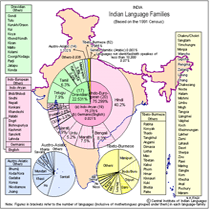THE LANGUAGES OF INDIA
Hindi in Devanagari script is the primary official language used by the Central Government of the Union of India. Article 343 of the Constitution of India states: "Clause (1)—the official language of the Union shall be Hindi in Devanagari script". Hindi language has been given the status of "National Language". Hindi along with English is the official language of communication of the Union Government of India (Central or Federal government). It is also the official language of the states Uttar Pradesh, Bihar, Jharkhand, Uttaranchal, Madhya Pradesh, Rajasthan, Chattisgarh, Himachal Pradesh, Haryana and the National Capital Territory of Delhi. Note again that English is the co-official language of the Indian Union, and that each of the several states mentioned above may also have another co-official language. Out of the 28 states and 7 union territories, Hindi is the official language in 10 states and 3 union territories.
Individual states, whose borders are mostly drawn on socio-linguistic lines, are free to decide their own language for internal administration and education; so there are 22 official languages spoken throughout the country, namely Assamese, Bengali, Bodo, Dogri, Gujarati, Hindi, Kannada, Kashmiri, Konkani, Maithili, Malayalam, Manipuri, Marathi, Nepali, Oriya, Punjabi, Sanskrit, Santhali, Sindhi, Tamil, Telugu and Urdu.
Sanskrit and Tamil are the classical languages of India. Both of them have very large collections of literature, with the earliest Sanskrit texts dating from 5000 years ago and the earliest Tamil literature from 2500 years ago. An official language, and the main language of Hindu liturgy, Sanskrit is also very much a living language. It is used in rituals and ceremonies or as part of daily prayers in Hinduism. Though not prevalent in every-day use, it is interestingly being revived as a spoken tongue in the village of Matthoor, in the Shimoga district of Karnataka. Telugu, a mellifluous language also known as 'Italian of the East', is another language with a notably ancient history and body of literature, and is widely used in Carnatic music.
In all, there are 24 languages which are spoken by a million or more people, in addition to thousands of smaller languages. Besides the Indo-Aryan and Dravidian languages, there are many Tibeto-Burman and Austro-Asiatic languages spoken in India, among others. The Andamanese languages, spoken on the Andaman Islands, are apparently not related to any other language family.
Three millennia of language contact situation have led to the convergence of four language families in India (and South Asia). Three contact languages have important role in the history of India/South Asia: Sanskrit, Persian and English.
Alphabets of Indian languages)
Indian languages have corresponding distinct alphabets. The two major families are those of the Dravidian languages and those of the Indo-Aryan languages, the former largely confined to the south and the latter to the north. With the exception of Urdu the alphabets of all these languages are native to India. There are those scholars who believe the scripts of the Northern languages (like Sanskrit, Bengali, Hindi and Punjabi) to be distant derivations of the Aramaic alphabet, though this is a disputed theory primarily because the number and grouping of sounds and letters are so radically different.
Phonetic alphabet
A remarkable feature of the alphabets of India is the manner in which they are organized. They are organized according to phonetic principle, unlike the Roman alphabet, which has a random sequence of letters.
The classification is as follows:-
| |
Unvoiced consonants |
Voiced consonants |
Nassals |
| |
unaspirated |
aspirated |
unaspirated |
aspirated |
|
| velar plosives |
k |
kh |
g |
gh |
ng |
| palatal affricates |
ch |
chh |
j |
jh |
ny |
| retroflex plosives |
t |
th |
d |
dh |
nn |
| dental plosives |
t |
th |
d |
dh |
n |
| bilabial plosives |
p |
ph |
b |
bh |
m |
This classification is observed in all the languages under discussion. Additionally each language has a few special letters signifying sounds specific to that language, as also a few symbols representing composite sounds.
Finally, the list of vowels is separately specified, as follows:-
a, aa, i, ii, u, uu, e, ai, o, au, um, (a)h
Additionally in Vedic Sanskrit: rr, rrr, lrr, lrrr
Note that the list read as pairs represents shorter and longer versions of same vowel. Here the first a is like u in bus. (a)h is special to Sanskritised words, occurring in word endings as in duhkh(a)h, meaning pain or suffering. It is impossible to say any of the consonants without the associated vowel and the default way of saying a consonant attaches the neutral a sound to it.
In languages of Eastern India like Bengali, Oriya and Assamese, a is spoken almost o.
The classification of these sounds is universal. Every language in India has a corresponding symbol, and also, with some modifications, the corresponding sound. In fact we may be tempted to think that all languages at least of the Indo-European family have the corresponding alphabets, give or take a few, and sometimes give or take a row or column.
For instance, English has morphemes similar to the t, th, d, and dh of the third row, but they manifest as only two phonemes, t and d. In French on the other hand, the third row is absent, but morphemes similar t and d of the fourth row are used.
For nasals, Sanskrit imposes considerable systematic. The above scheme records that the nasal occurring in conjunction with any given row has a sound characteristic that row. For instance the nasalization occurring in the word "Ganga" is that of the first row, while the nasalization occurring in the words "India" or "integral" are character- istically front palatals. Speakers of any language have to necessarily speak in this manner though they never realise it.
The classification of the "vowel generated" may seem rather curious. The belief here is that y sound arises from conjunction of ii with a, w sound arises from trying to say u (as in put) or uu in conjunction with a. Old Sanskrit of the Hindu Rig Veda has two more vowels, rr and lrr, as also their corresponding longer versions. It is likely that the rr was guttural like the French r, more akin to a vowel than a consonant. The lrr remains a mystery for being classified a vowel. But this classification then explains r (as in run) and l (as in long) simply as conjunction of these vowels with a sound.
The economy of this classification in the fact that effectively each of the five main rows is generated by one letter, the others are systematic modifications of the same. In Tamil, a great simplification of alphabet has been achieved by having only one symbol for each of the five consonants, with the specific hardening and aspiration understood from context while reading. Tamil script indeed spells kathai (story) and Gandhi (mace - weapon of Bhima) the same.
Our Commitment
Qualify work, delivery within given time schedule, value the time of client and his money, failure which No charges, project free of cost
















